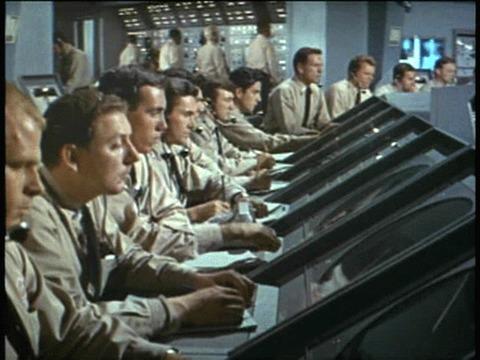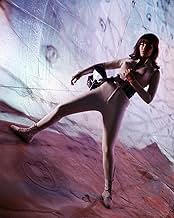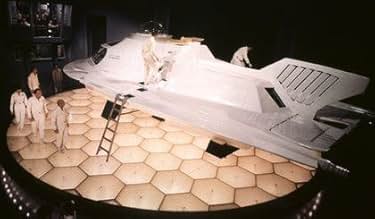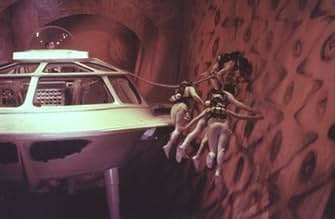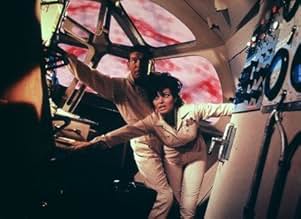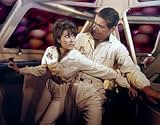VALUTAZIONE IMDb
6,8/10
21.837
LA TUA VALUTAZIONE
Uno scienziato è quasi assassinato. Per salvarlo, un sottomarino viene ridotto a dimensioni microscopiche e iniettato nel suo flusso sanguigno con un piccolo equipaggio. I problemi sorgono q... Leggi tuttoUno scienziato è quasi assassinato. Per salvarlo, un sottomarino viene ridotto a dimensioni microscopiche e iniettato nel suo flusso sanguigno con un piccolo equipaggio. I problemi sorgono quasi non appena vi entrano.Uno scienziato è quasi assassinato. Per salvarlo, un sottomarino viene ridotto a dimensioni microscopiche e iniettato nel suo flusso sanguigno con un piccolo equipaggio. I problemi sorgono quasi non appena vi entrano.
- Regia
- Sceneggiatura
- Star
- Vincitore di 2 Oscar
- 4 vittorie e 6 candidature totali
Brendon Boone
- Military Policeman
- (non citato nei titoli originali)
James Doohan
- Dr. Sawyer - Hypothermia Technician
- (non citato nei titoli originali)
Kenneth MacDonald
- Henry - Heart Monitoring
- (non citato nei titoli originali)
Christopher Riordan
- Young Scientist
- (non citato nei titoli originali)
Recensioni in evidenza
To answer everyone's question about how did Issac Asimov resolve the Proteus issue at the end of the movie; in his novelization of the film (which is a very good sci-fi book on its own), the sub comes out with everyone else in the teardrop along with "a very surprised white blood cell." The scene with Donald Pleasance gave me chills when I saw it as a child and having recently seen it again, it still is creepy. I think this is due to Pleasance's performance more than anything else. I do have to say that seeing Stephen Boyd being driven around the LA Sports Center (subbing for the top secret research center; they had to have everything removed by 5:30 in the afternoon the week they filmed there because sporting events were going on at night) in a golf cart seemed a bit silly but I guess that showed how important he was. With these kinds of films, one has to ignore all certain types of questions about how come this did or didn't happen when the scientists did this and just relax and enjoy it.
Back in 1966, long, long before the world was turned upside down and inside out on Sept. 11, the world was a very different place. The movies were quite different and science fiction pictures depended more on good writing and less on special effects. Partly because the phrase "computer generated" was years away. In 1966, 20th Century Fox released a very clever, well-written and innovative movie called, "Fantastic Voyage". The on-screen foreword informed the viewers that they were going to be taken to a place that no one had been before, and see things that had been, until that point in time, never been seen by human beings. I'm sure that this film had its fair share of technical advisors putting in a lot more than their 2 cents worth to make sure that the film accurately depicted human anatomy. The plot... A scientist, Jan Benes, has defected from behind the Iron Curtain, has, with the help of Grant, one of our top CIA operatives. Benes has decided to give his expertise with Miniaturization to the US. The "other side" has no choice but to try to kill him before he can breathe a word of it. The assassination attempt is made, but Benes barely survives, falling into a coma. After the movie's credits finish rolling, Grant is brought to a secret, gov't location. There, he meets Gen. Carter, who is in charge of the CMDF - Combined Miniature Deterent Forces. They can shrink anything; cars, planes, tanks, people way down in size, thus enabling them to become unseen military weapons. The problem: both sides have this capability. Another problem is... there is a time limit. They can only stay miniaturized for 60 minutes. After that the object or person automatically starts to grow. Benes had the answer to this problem, but he will need special medical treatment to regain consciousness. That's where Grant and a special team of doctors, technicians and such will have to go into action. After Grant meets the rest of the team, the surgeons in charge, Dr. Duvall and Dr. Michaels go over their plan to remove the blood clot in Benes' brain. They will board a special Navy submarine, called The Proteus, be miniaturized and injected into Benes' body by hypodermic needle. Naturally, the crew runs into Murphy's Law and a job that was expected to take 10 to 15 minutes takes much, much longer. The ending in the movie differs quite a bit from the book written by Isaac Azimov (I know because I read it... twice), and there are a number sub-plot twists that made me shake my head, but seeing Ms. Welch in that wet suit made it more than worth while. I consider this movie to be one of my very favorite sci-fi/fantasy flicks from the '60s. If you haven't seen it yet, for whatever reason, I can suggest you spend the 100 minutes with some very fine actors, some of whom are no longer with us, such as Stephen Boyd (Grant), Edmund O'Brien (Gen. Carter) and Arthur O'Connell who was in charge of the medical team, and others like Arthur Kennedy (Dr. Duvall), Donald Pleasence (Dr. Michaels) and last but not least, the ever-beautiful, Raquel Welch as Cora Peterson, Dr. Duval's technical assistant. One last thought.... if this movie was remade with present-day technology, i.e. computer generated imaging and the like, there's no telling how it would dazzle the viewers' eye.
Fantastic Voyage boasted great special effects for its day. It also is a neat fantasy thriller being a race against the clock with a saboteur on board.
Agent Charles Grant (Stephen Boyd) has been bought in fo a secret mission. Jan Benes is a scientist who has been injured while escaping from Russia. He has a blood clot on the brain.
In order to save Benes life. American scientists will miniaturize a nuclear submarine, inject it into Benes' body and fix the clot. They have 60 minutes to do this before the submarine returns to its normal size.
Grant is warned that the surgeon Dr Duval might also be an assassin. Once they get inside the body, it is a bumpy ride and nothing seems to go according to plan.
Director Richard Fleischer manages to stay on the right side of camp. The film takes a while to get going but once inside the body, it is a nicely crafted and well paced movie with lots of suspense.
Raquel Welch is suitable eye candy. The special effects as the submarine goes through the bloodstream has a psychedelic touch. It is just a shame that the villain is a little too obvious.
Agent Charles Grant (Stephen Boyd) has been bought in fo a secret mission. Jan Benes is a scientist who has been injured while escaping from Russia. He has a blood clot on the brain.
In order to save Benes life. American scientists will miniaturize a nuclear submarine, inject it into Benes' body and fix the clot. They have 60 minutes to do this before the submarine returns to its normal size.
Grant is warned that the surgeon Dr Duval might also be an assassin. Once they get inside the body, it is a bumpy ride and nothing seems to go according to plan.
Director Richard Fleischer manages to stay on the right side of camp. The film takes a while to get going but once inside the body, it is a nicely crafted and well paced movie with lots of suspense.
Raquel Welch is suitable eye candy. The special effects as the submarine goes through the bloodstream has a psychedelic touch. It is just a shame that the villain is a little too obvious.
The premise of "Fantastic Voyage" seemed very unlikely in 1966, however in 2002 I'm not so sure.
The story concerns a top secret miniaturization program being developed by the Americans and concurrently by "the other side". A scientist from the other side has the secret of counteracting the situation where the miniaturization effects wear off after one hour. Unfortunately, the scientist receives a brain injury in an assassination attempt. This results in General Carter (Edmond O'Brien), the commanding officer of the project deciding to "send in" a team of experts miniaturized, to the injured man's brain to repair the damage.
The team consists of Drs. Duval (Arthur Kennedy) and Michaels (Donald Pleasance), Pilot Capt. Owens (William Redfield) and the romantic leads, Grant (Stephen Boyd) and the ever lovely Raquel Welch as Duval's assistant. Assisting O'Brien as a medical expert is Arthur O'Connell as Col. Reid. Of course, as in most film's of this type there is the inevitable fifth columnist aboard. The acting is good, particluarly the performances of veterans Kennedy, Pleasance, O'Brien and O'Connell.
The real star of the "Fantastic Voyage" are its amazing special effects. Filmed long before today's computerized digital effects, this film still makes believable, the illusion of a team of people being injected into a person's bloodstream. To fully appreciate the effects the viewer should see it in its widescreen format.
Watch for James Brolin in a small role as one of the lab technicians. And if you get bored, there's always (snort, pant, drool) Raquel in her form fitting diving suit.
The story concerns a top secret miniaturization program being developed by the Americans and concurrently by "the other side". A scientist from the other side has the secret of counteracting the situation where the miniaturization effects wear off after one hour. Unfortunately, the scientist receives a brain injury in an assassination attempt. This results in General Carter (Edmond O'Brien), the commanding officer of the project deciding to "send in" a team of experts miniaturized, to the injured man's brain to repair the damage.
The team consists of Drs. Duval (Arthur Kennedy) and Michaels (Donald Pleasance), Pilot Capt. Owens (William Redfield) and the romantic leads, Grant (Stephen Boyd) and the ever lovely Raquel Welch as Duval's assistant. Assisting O'Brien as a medical expert is Arthur O'Connell as Col. Reid. Of course, as in most film's of this type there is the inevitable fifth columnist aboard. The acting is good, particluarly the performances of veterans Kennedy, Pleasance, O'Brien and O'Connell.
The real star of the "Fantastic Voyage" are its amazing special effects. Filmed long before today's computerized digital effects, this film still makes believable, the illusion of a team of people being injected into a person's bloodstream. To fully appreciate the effects the viewer should see it in its widescreen format.
Watch for James Brolin in a small role as one of the lab technicians. And if you get bored, there's always (snort, pant, drool) Raquel in her form fitting diving suit.
This is not only a great science fiction film, it is also a great thriller as well. I especially loved the fact that this was supposedly done in "real time" and that the characters and that it was not only a mission to save the scientist life, but a race against time before the miniaturization wore off. Also, even though the effects are dated, they still were pretty good for the era they were produced in.
Lo sapevi?
- QuizMedical schools, at least as late as the 1980s, showed clips from this movie to illustrate various concepts in human anatomy, physiology, and especially immunology.
- BlooperThe amount of radioactive material for the sub would not need a lead carrying case. Grant proves this by removing the container from the case with no protection and handing it to Owens who inserts it into the reactor, again bare-handed.
- Versioni alternativeThe DVD edition has the following prologue: "The makers of this film are indebted to the many doctors, technicians and research scientists, whose knowledge and insight helped guide this production" The TV/Video version features this prologue instead: "This film will take you where no one has ever been before; no eye witness has actually seen what you are about to see. But in this world of ours where going to the moon will soon be upon us and where the most incredible things are happening all around us, someday, perhaps tomorrow, the fantastic events you are about to see can and will take place."
- ConnessioniEdited into Attack of the 50 Foot Monster Mania (1999)
I più visti
Accedi per valutare e creare un elenco di titoli salvati per ottenere consigli personalizzati
Dettagli
- Data di uscita
- Paese di origine
- Lingua
- Celebre anche come
- Fantastic Voyage
- Luoghi delle riprese
- Los Angeles Memorial Sports Arena - 3939 S. Figueroa Street, Los Angeles, California, Stati Uniti(interior corridors of CMDF headquarters traversed by golf carts and people walking)
- Azienda produttrice
- Vedi altri crediti dell’azienda su IMDbPro
Botteghino
- Budget
- 5.115.000 USD (previsto)
- Tempo di esecuzione1 ora 40 minuti
- Colore
- Proporzioni
- 2.35 : 1
Contribuisci a questa pagina
Suggerisci una modifica o aggiungi i contenuti mancanti

Divario superiore
By what name was Viaggio allucinante (1966) officially released in India in English?
Rispondi
